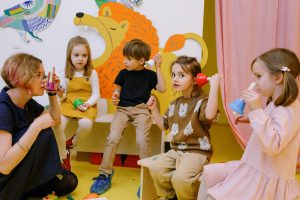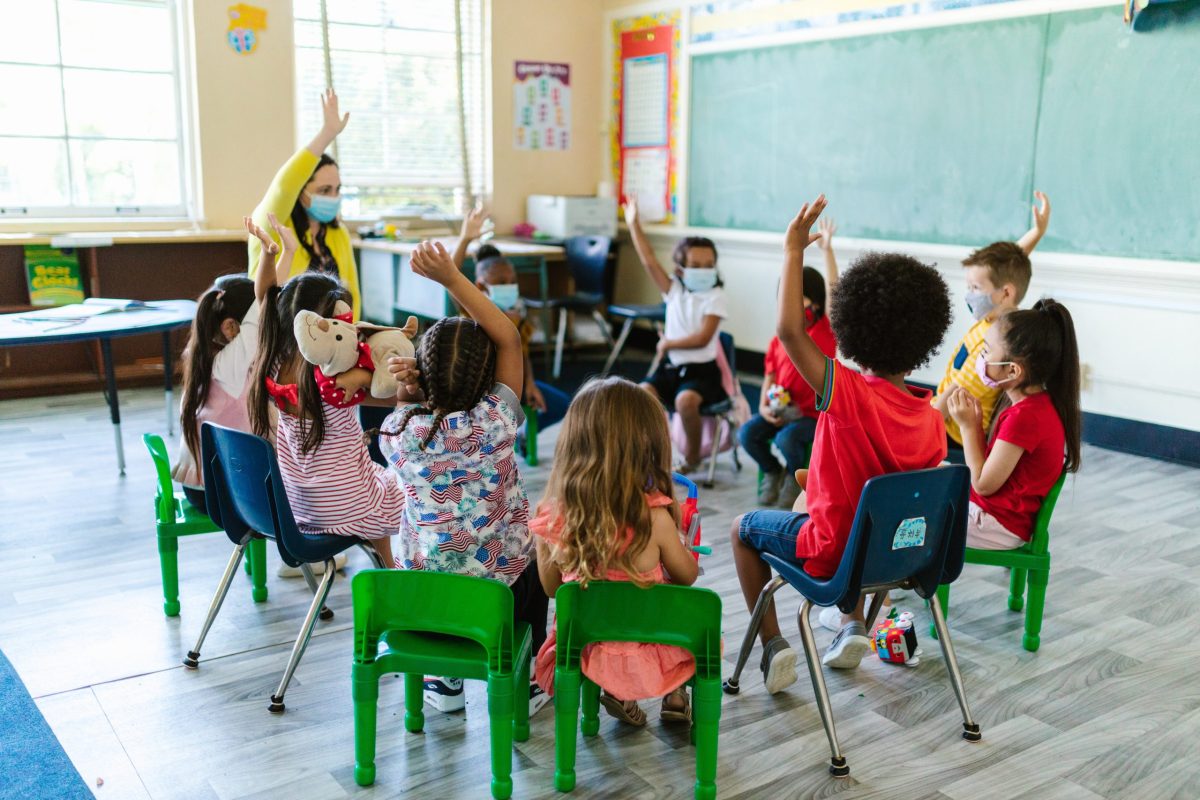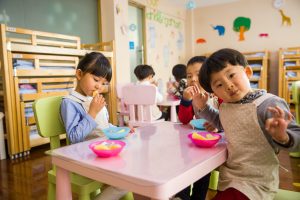Montessori Social Environment
From the moment you walk into a Montessori classroom, it’s clear that it’s different than traditional classrooms. The environment is calm and inviting. In place of worksheets or lecturing teachers, the room is filled with beautiful, hands-on materials. Children of many ages and stages work alongside each other, collaborating and helping one another. The classroom isn’t just special because of the materials or prepared environment, but also because of the Montessori social environment.
The Montessori social environment is a unique approach that helps children learn from their peers, find opportunities to help other children, and develop important life skills. Maria Montessori developed her method after extensive observation of children and how they learn best, and the social aspect of her method is no exception.
In this article, we’ll break down a few practices that make the Montessori social environment effective and how parents can apply these simple principles in their homes.

Key Practices of the Montessori Social Environment
Mixed-Age Classrooms
Mixed-age environments are a key element that set apart the Montessori social environment. Infants from 0-18 months are in one classroom. Toddlers are together from 18 months to 3 years. Children’s House is for children 3-6 years old, with lower elementary for kids ages 6-9 and upper elementary for kids ages 9-12.
Working alongside children of many different ages offers many opportunities for learning that would be impossible in a traditional classroom. Younger children can learn by observing older children. They may gain interest in a material after seeing an older child work with it. Apart from academic work, younger children can also learn from an older child’s social skills and language.
 The older children in the classroom naturally receive more opportunities for responsibility and step into leadership roles. Older children can teach what they’ve learned to younger children. In fact, Montessori teachers often gauge a child’s mastery of a material by observing the child teach it to another.
The older children in the classroom naturally receive more opportunities for responsibility and step into leadership roles. Older children can teach what they’ve learned to younger children. In fact, Montessori teachers often gauge a child’s mastery of a material by observing the child teach it to another.
Mixed-age classrooms also mean that Montessori teachers often stay with the same students for a longer period of time. Rather than starting over with a new teacher every school year, children can return to a teacher they’ve already built a relationship with.
Science backs up this approach. One 2021 research study and literature review on multi-age classrooms found that a child’s learning capability “grows tremendously” in a multi-age classroom. The study also found social and emotional benefits to this approach, stating that it helps build problem-solving skills and encourages cooperation.
Mixed-Age Environments at Home
In many ways, Dr. Montessori designed her classrooms to replicate the home environment, not the other way around.
For example, mixed-age classrooms replicate the experience of having siblings of various ages at home. While it can sometimes feel overwhelming to homeschool multiple children at different ages and developmental levels, parents can rest easy knowing that mixed-age environments actually benefit their children’s learning.
Families with one child can also find ways to incorporate the benefits of mixed-age environments. You may consider organizing a homeschool group or play date with kids of various ages. Even playing at the park can offer opportunities for mixed-age play.
Grace and Courtesy Lessons

The Montessori method is a holistic approach, meaning that it focuses on every aspect of a child’s development, not just academics. Montessori isn’t just about teaching children what to know, but also about teaching them how to be.
In Montessori environments, children learn how to respect their peers and their environments, the appropriate ways to approach situations in their culture, and how to be good citizens.
One way children learn these lessons is through grace and courtesy lessons. In these lessons, usually taught in large or small groups, Montessori guides teach children basic skills and manners to help them succeed socially. Examples include lessons in how to interrupt someone who is working, how to politely walk around a workspace, or how to greet someone.
These lessons help develop a children’s social skills and awareness, all contributing to a positive and educational social environment. Learning about how to interact politely and respectfully in a low-pressure group setting can help children internalize and apply these lessons.
Grace and Courtesy Lessons at Home
Homeschool families can incorporate grace and courtesy lessons into their Montessori homeschool routines. Part of the reason these lessons are so effective is because they teach principles in a low-pressure, non-accusatory setting. Instead of telling a child when they’re doing something wrong, these lessons teach children the skills they need beforehand, setting them up to succeed.
Consider doing the same at home. Start by observing and noting what skills your child needs to learn so you can teach them at another time.
For example, instead of chastising your toddler for interrupting you on the phone, make a note to later teach a grace and courtesy lesson on the topic the next day. Positive reinforcement is more powerful than negative reinforcement.
Shared Meals
Shared meals, also called Montessori family-style dining, are another key element of the Montessori social environment. In Montessori, eating isn’t just for filling up bellies — it’s for working together and developing social skills and manners.
 Children prepare food, eat it, and clean it up together in Montessori environments. This experience offers invaluable opportunities to help children work together toward a common goal. It helps them learn their important, contributing role to their home or classroom.
Children prepare food, eat it, and clean it up together in Montessori environments. This experience offers invaluable opportunities to help children work together toward a common goal. It helps them learn their important, contributing role to their home or classroom.
At mealtimes, children socialize and learn manners. They build relationships with their peers and teachers and learn the value in the social experience of communal eating.
Shared Meals at Home
Just like at school, mealtime at home is an invaluable time to connect. As a parent, it can be tempting to use mealtimes to get caught up on dishes or get a break in by reading a book or scrolling online. But treating mealtime as a time for connection can help fill up a child’s emotional cup and foster powerful moments for bonding and discussion.
Parents can also encourage their children to help prepare food and clean up after eating. Child-sized utensils, like the ones found in the Helping Hands Toolbox, can facilitate this process for little hands.
Replicating the Montessori Social Environment at Home
These powerful practices are just a few of many that make the Montessori social environment so effective in helping children learn and build their social skills. Even better? These practices can be seamlessly applied at home to help your children reap the benefits of Montessori at home.
What differences have you seen as you’ve applied these practices at home? We’d love to hear more about it in the comments below!




0 Comments